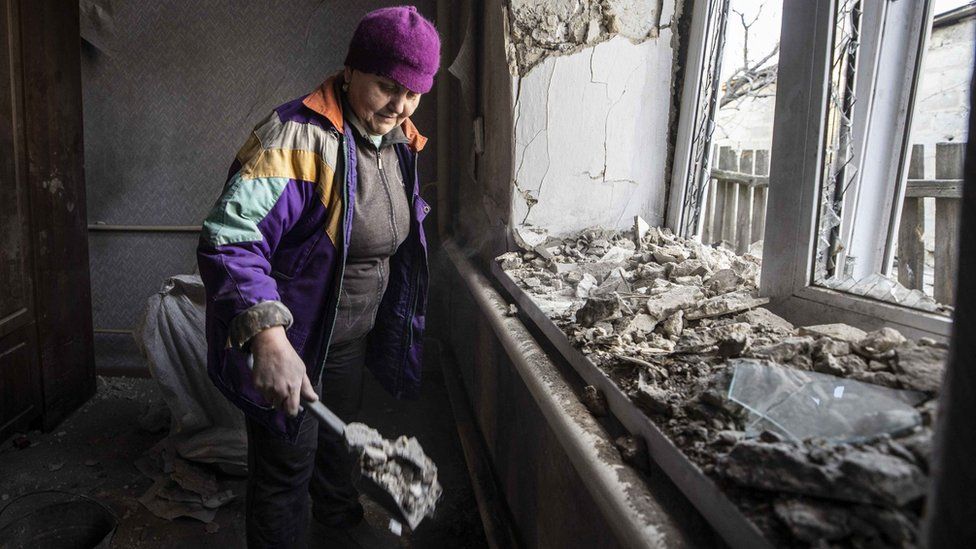How hard will it be for Ukraine to defend itself now that an attack by Russia has begun? Ukraine is outgunned and outnumbered right across the board - after significant investment and modernisation in Russia's armed forces by President Putin.
Dr Jack Watling, of the Royal United Services Institute, says: "I think the Ukrainians are in a very difficult position." He's just returned from Ukraine and says the country's military leaders now face some "very hard choices".
Western officials estimate that Russia had up to 190,000 troops on Ukraine's border - far more than Ukraine's entire regular army of 125,600.
Russian forces are already crossing the border from multiple directions.
Black smoke rises from a military airport in Chuhuyev near Kharkiv on February 24, 2022
IMAGE SOURCE,GETTY IMAGES
Image caption,
The military airport at Chuhuyev near Kharkiv was among targets hit first by Russia
Ukraine will find it hard to defend thousands of miles of its frontier - from Belarus in the north all the way down to Crimea in the south. If you think of Ukraine as a clock face, the Russians can mount attacks from 10 o'clock to 7 o'clock.
Ben Barry, of the International Institute of Strategic Studies (IISS) and a former British Army brigadier, says it's a "very difficult position for a defender".
Added to that, Ukraine is being threatened in multiple directions and their forces are "spread pretty thinly", Jack Watling of the Royal United Services Institute (RUSI) says.
Russia's dominance in the air
But the real disparity between Russian and Ukrainian forces is in the sky.
Ukraine has 105 combat aircraft on the border compared with Russia's 300, Mr Watling says. The Russians, he predicts, "will very quickly gain air superiority".
Russia's advanced air defence systems, such as S-400 missiles, also gives its forces an advantage. In contrast, Ukraine has older and more limited air defences.
Mr Watling gives the example of Israel being able to defend itself from multiple directions. But he adds it's only been able to do so because of its superiority in the air. That's something Ukraine simply doesn't have.
Moscow has developed its own version of "shock and awe" with integrated air, missile and long-range rocket artillery, says Ben Barry.
It allows the Russians to attack Ukraine's command and control centres, ammunition depots, air force and air defences from far away.
That already appears to have begun, with cruise missile attacks on targets near the capital Kyiv.
Mr Watling says the Russians have a very significant arsenal of modern weapons and capabilities that Ukraine doesn't have an answer to - like the Iskander cruise and ballistic missile systems.
Ukraine has recently received supplies of "lethal aid" from the US and the UK, but these are mostly short-range air-to-air missiles and anti-tank weapons.
In short, Russia outguns and outranges Ukraine.
Map showing explosions in Ukraine
1px transparent line
With Russia's air superiority and long-range weapons, the danger for Ukraine's forces is that they'll soon be pinned down.
Ukraine's forces could be stopped from being able to manoeuvre and reposition to face the Russian advance from any other direction, Mr Watling believes.
Many of Ukraine's best trained and equipped units are in the east of the country - near the line of control in Luhansk and Donetsk - where there's been fighting since 2014.
Western intelligence officials have told the BBC there's a real worry that Russia could try to encircle them.
However, Ukraine's armed forces are better trained and equipped than they were when Russia invaded Crimea.
Mr Barry says units and soldiers have gained useful battle experience from the fight with Russian-backed separatists in the east of the country.
But he adds they've mainly been involved in linear trench warfare and the demands of "manoeuvre warfare" will be much harder.
Russia's forces are able to move quickly with mobile rocket and missile launchers and air defences. Russian troops, too, have been battle hardened from its invasion of Crimea, and in Syria.
Fighting in the cities
If the fighting enters Ukraine's towns and cities then that might give Ukraine's forces a chance.
A well prepared defender can make urban fighting difficult and bloody for any attacker - as shown in Stalingrad in World War Two and more recently in Mosul in Iraq.
A woman cleans her damaged house after artillery fire from Donetsk region under the control of pro-Russian separatists in Donbas on February 23, 2022 in Mar'inka, Ukraine.
IMAGE SOURCE,ANADOLU AGENCY VIA GETTY IMAGES
Image caption,
A woman cleans her damaged house after artillery fire from an area of Donetsk under the control of Russian-backed rebels
Ben Barry believes that Russian forces may initially try to bypass towns and cities. But he believes it's very unlikely that the Russians can avoid urban combat, not least in Kyiv given its political significance.
Jack Watling says if Ukraine can defend its cities properly then they might be able to hold out for quite a long time.
British-supplied light anti-tank weapons (also known as NLAWs) may help in close combat where Ukrainian forces can move around using the cover of buildings. An unknown number of civilians could also take up arms.
Russia cannot just rely on airstrikes and artillery to control towns and cities.
But Mr Watling says Russia already has agents and operatives on the ground. He says "there will be subversion and unconventional operations in Kyiv to try and destabilise the government". Russia, he adds, will also try to encircle cities and use long-range artillery to target pockets of resistance and then try to use special forces and agents to "essentially murder civil society leaders".
Ukraine is now fighting for its survival.
It's been engaged in combat with Russian-backed forces in the east for the past eight years, but the threat is now an existential one for the entire country.
Having just visited Ukraine, Mr Watling says there is a "grim determination to survive as a country, but there is a recognition that they are overmatched and that it's going to be exceedingly bloody".
Oxu24.com




































ŞƏRHLƏR